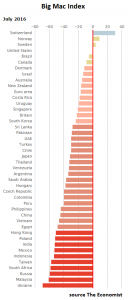In 2014, the average gross annual salary for a full-time male worker in Switzerland was CHF 81,000, CHF 10,000 or 12.5% higher than that of an average woman. But what does this high level difference mean?
Inspired by the Swedish statistician Hans Rosling, who passed away recently, I decided to dig deeper to see what was behind this top line pay difference.
Hans Rosling had a knack for using statistics to expose bias and our inbuilt tendency to overlook change. He would take numbers from the UN and show how things like family size and poverty had declined enormously. His statistics revealed that Sweden’s best students know less about the world than chimpanzees.
[embedded content]
In addition, he would show how much information was lost when aggregated numbers are used. In one example he showed how child survival rates vary more across Africa than they do across the entire world, when data are aggregated into broad clumps.
So how do Swiss gender pay differences look when broken down?
The information available at the Swiss statistics office gives pay gaps for 38 occupational groups, broken down into three age segments.
Gender pay differences increase dramatically with age. The aggregate difference for those under 30 was 5%, well below the overall average of 12.5%.
Articles by Phillip Judd
Swiss analysis: Switzerland’s gender pay gap – what the detail reveals
February 17, 2017In 2014, the average gross annual salary for a full-time male worker in Switzerland was CHF 81,000, CHF 10,000 or 12.5% higher than that of an average woman. But what does this high level difference mean?
Inspired by the Swedish statistician Hans Rosling, who passed away recently, I decided to dig deeper to see what was behind this top line pay difference.
Hans Rosling had a knack for using statistics to expose bias and our inbuilt tendency to overlook change. He would take numbers from the UN and show how things like family size and poverty had declined enormously. His statistics revealed that Sweden’s best students know less about the world than chimpanzees.
In addition, he would show how much information was lost when aggregated numbers are used. In one example he showed how child survival rates vary more across Africa than they do across the entire world, when data are aggregated into broad clumps.
So how do Swiss gender pay differences look when broken down?
The information available at the Swiss statistics office gives pay gaps for 38 occupational groups, broken down into three age segments.
Gender pay differences increase dramatically with age. The aggregate difference for those under 30 was 5%, well below the overall average of 12.5%. For those between 29 and 50 the gap climbed to 10%.
Switzerland has world’s priciest Big Macs. So eat Swiss chocolate instead.
August 1, 2016The Economist invented the Big Mac index in 1986 as a tongue-in-cheek guide to currency valuations. Because the well-known burger is the same throughout much of the world, the magazine thought it could be used as a measure of how over or undervalued a currency was. An overpriced burger suggests an overvalued currency and a cheap one an undervalued currency.
© Mirko Vitali | Dreamstime.com
As it did last year, Switzerland topped the chart this year with the world’s most expensive Big Macs. At US$ 6.59 (CHF 6.50) the Swiss price for the double layered burger far outstripped second placed Norway (US$ 5.51). In the US the triple-bunned meal cost US$ 5.04, and in the Ukraine, the cheapest place, it cost only US$1.57. What does this mean? It suggests the Swiss franc is 30.8% overvalued.
A key criticism of the index is that it ignores the higher cost of labour in richer countries. To correct for this the Economist has created an adjusted index, which calculates Big Mac prices relative to average national incomes (GDP per person). Rich countries pay workers more, so Big Macs should cost more there. After making this adjustment, Switzerland loses its top spot to Brazil where the US$ 4.78 burger overvalues the Brazilian Real by 54.2%. On this measure the Swiss franc is only 8.7% overvalued.
Let them eat chocolate
If this logic works for Big Macs then it ought to work for other products.
Switzerland has world’s priciest Big Macs. So eat Swiss chocolate instead.
August 1, 2016The Economist invented the Big Mac index in 1986 as a tongue-in-cheek guide to currency valuations. Because the well-known burger is the same throughout much of the world, the magazine thought it could be used as a measure of how over or undervalued a currency was. An overpriced burger suggests an overvalued currency and a cheap one an undervalued currency.
As it did last year, Switzerland topped the chart this year with the world’s most expensive Big Macs. At US$ 6.59 (CHF 6.50) the Swiss price for the double layered burger far outstripped second placed Norway (US$ 5.51). In the US the triple-bunned meal cost US$ 5.04, and in the Ukraine, the cheapest place, it cost only US$1.57. What does this mean? It suggests the Swiss franc is 30.8% overvalued.
A key criticism of the index is that it ignores the higher cost of labour in richer countries. To correct for this the Economist has created an adjusted index, which calculates Big Mac prices relative to average national incomes (GDP per person). Rich countries pay workers more, so Big Macs should cost more there. After making this adjustment, Switzerland loses its top spot to Brazil where the US$ 4.78 burger overvalues the Brazilian Real by 54.2%. On this measure the Swiss franc is only 8.7% overvalued.
Click to enlarge.
Read More »How immigration makes Switzerland the world’s most inventive nation
March 7, 2016Swiss resident companies and individuals applied for more patents than those in the UK in 2015. The European patent office’s recently released annual report, shows there were 7,088 Swiss-based european patent applications compared to the UK’s 5,037. On the face of it these numbers are not too far apart. On a per capita basis there is a more than tenfold difference. Switzerland filed 873 european patents per million residents. The UK filed 79. In addition, Switzerland is well ahead of its neighbours: Germany (307), France (162), and Italy (64).
The US was number one with 42,692 european patent applications in 2015, but with a population of 321 million its rate per million inhabitants was only 133, far behind Switzerland’s 873.
Why is Switzerland’s innovation rate so high?
How does Switzerland manage to invent at a rate more than double the Netherlands, the nation in second place with 419 patent applications per million residents, and more than 6 times the rate of the US?
A paper published by Ernest Miguelez and Carsten Fink at Geneva-based WIPO (World Intellectual Property Organisation) in 2013 offers clues.
Switzerland was one of only three countries to have a significant net inflow of inventors between 2001 and 2010. Only the US, which attracted 194,609 foreign inventors, and Germany, which attracted 25,341, out-did Switzerland at pulling in innovators from other countries.





